Phylogenic tree - Study guides, Class notes & Summaries
Looking for the best study guides, study notes and summaries about Phylogenic tree? On this page you'll find 31 study documents about Phylogenic tree.
All 31 results
Sort by
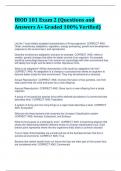
-
BIOD 101 Exam 2 (Questions and Answers A+ Graded 100% Verified)
- Exam (elaborations) • 2 pages • 2023
-
Available in package deal
-
- $7.99
- 6x sold
- + learn more
BIOD 101 Exam 2 (Questions and Answers A+ Graded 100% Verified) List the 7 most widely accepted characteristics of living organisms CORRECT ANS: Order, evolutionary adaptation, regulation, energy processing, growth and development, response to the environment, and reproduction Describe evolutionary adaptation and give an example CORRECT ANS: refers to smaller, genetic changes that allow for better survival of an organism. An example would be camouflage because if an animal can camo...
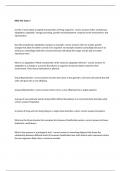
-
BIOD 101 Exam 2 questions and verified correct answers
- Exam (elaborations) • 3 pages • 2023
-
Available in package deal
-
- $10.99
- 1x sold
- + learn more
List the 7 most widely accepted characteristics of living organisms correct answers Order, evolutionary adaptation, regulation, energy processing, growth and development, response to the environment, and reproduction Describe evolutionary adaptation and give an example correct answers refers to smaller, genetic changes that allow for better survival of an organism. An example would be camouflage because if an animal can camouflage with their environment they will ideally live longer and be ...
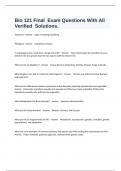
-
Bio 121 Final Exam Questions With All Verified Solutions.
- Exam (elaborations) • 8 pages • 2024
-
Available in package deal
-
- $9.69
- + learn more
Taxonomy - Answer study of naming/classifying Phylogeny - Answer evolutionary history In a phylogenic tree, what does a longer line infer? - Answer That it took longer for evolution to occur between the two species than the two species with the shorter line. What are the six kingdoms? - Answer Archae Bacteria, Eubacteria, Protista, Plantae, Fungi, Animalia What kingdom was split to create the sixth kingdom? - Answer Monera was split into Archae Bacteria and Eubacteria ...
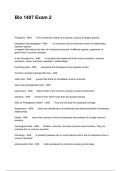
-
Bio 1407 Exam 2 Questions Rated And Verified 100%
- Exam (elaborations) • 16 pages • 2024
-
- $10.29
- + learn more
Phylogeny - ANS The evolutionary history of a species or group of related species phylogenic tree/cladogram - ANS - to reconstruct the evolutionary history of relationships between species a diagram that depicts the lines of evolutionary descent of different species, organisms, or genes from a common ancestor. A tree through time - ANS A complete tree implies all of the events (evolution: common ancestors, nodes, branches, speciation, relationships) branching point - ...
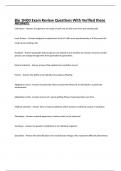
-
Bio 1M03 Exam Review Questions With Verified these Answers
- Exam (elaborations) • 14 pages • 2024
-
- $10.99
- + learn more
Cell theory - Answer all organisms are made of cells and all cells come from pre-existing cells Louis Pasteur - Answer designed an experiment to test if cells arose spontaneously or if they were the result of pre-existing cells Evolution - Answer postulates that (a) species are related to one another by common ancestry and (b) species can change through time from generation to generation. Natural selection - Answer process that explains how evolution occurs Fitness - Answer the abil...

-
Biology 1108 Final Exam Quiz Questions with 100% pass
- Exam (elaborations) • 15 pages • 2024
- Available in package deal
-
- $12.49
- + learn more
Biology 1108 Final Exam Quiz Questions with 100% pass The term "n" refers to the size of a population, that is, the number of individuals in that population. In general, in a sample of n individuals, the frequency of an allele is: - Correct Answer ️️ -the number of occurrences of the allele divided by twice the number of individuals in the sample (2n) If a population is not in Hardy-Weinberg equilibrium, we can conclude that: - Correct Answer ️️ -evolution has occurred because on...

-
UTA Microbiology Exam 1 (Ch 1, 2, 3, 7) Latest Update 100% Solved
- Exam (elaborations) • 7 pages • 2024
- Available in package deal
-
- $9.99
- + learn more
UTA Microbiology Exam 1 (Ch 1, 2, 3, 7) Latest Update 100% Solved Microbiology The study of microscopic organisms. Have ubiquitous nature (everywhere), some beneficial, some neutral, some pathogenic (disease-causing) Antoine van Leeuwenhoek Father of microbiology. Invented a microscope strong enough to view microbes "animalcules". Giralamo Fracastoro Regarded as first person to formally postulate that disease was spread by tiny invisible seminaria "seeds of contagion". Robe...

-
Biology 1108 Final Exam Quiz Questions with 100% pass
- Exam (elaborations) • 15 pages • 2024
-
- $12.49
- + learn more
Biology 1108 Final Exam Quiz Questions with 100% pass The term "n" refers to the size of a population, that is, the number of individuals in that population. In general, in a sample of n individuals, the frequency of an allele is: - Correct Answer ️️ -the number of occurrences of the allele divided by twice the number of individuals in the sample (2n) If a population is not in Hardy-Weinberg equilibrium, we can conclude that: - Correct Answer ️️ -evolution has occurred because on...

-
Biology 1108 Final Exam Quiz Questions with 100% pass
- Exam (elaborations) • 15 pages • 2024
- Available in package deal
-
- $12.49
- + learn more
Biology 1108 Final Exam Quiz Questions with 100% pass The term "n" refers to the size of a population, that is, the number of individuals in that population. In general, in a sample of n individuals, the frequency of an allele is: - Correct Answer ️️ -the number of occurrences of the allele divided by twice the number of individuals in the sample (2n) If a population is not in Hardy-Weinberg equilibrium, we can conclude that: - Correct Answer ️️ -evolution has occurred because on...
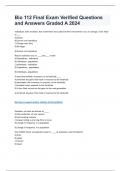
-
Bio 112 Final Exam Verified Questions and Answers Graded A 2024
- Exam (elaborations) • 19 pages • 2024
-
Available in package deal
-
- $12.99
- + learn more
Individuals with variations that make them best suited to their environment are, on average, more likely to ___ A) Evolve B) Survive and reproduce C) Change over time D) Be larger B) Survive and reproduce Natural selection acts on ___, and ___ evolve A) Populations, individuals B) Individuals, populations C) Individuals, individuals D) Populations, populations B) Individuals, populations A weed that exhibits resistance to an herbicide ___ A) inherited the gene that made it resistant...

$6.50 for your textbook summary multiplied by 100 fellow students... Do the math: that's a lot of money! Don't be a thief of your own wallet and start uploading yours now. Discover all about earning on Stuvia


